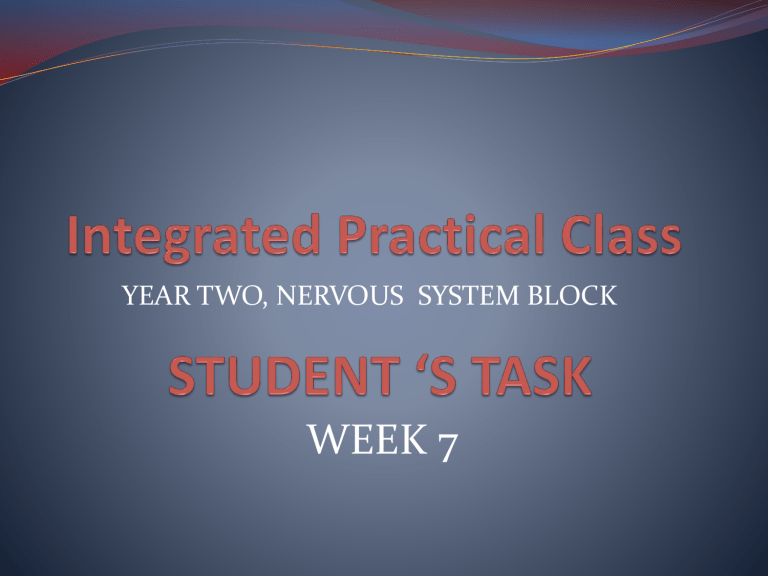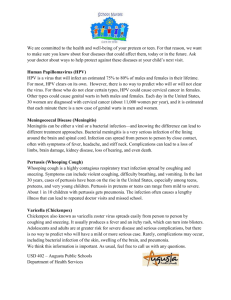Lecture 1 - King Saud University Medical Student Council

YEAR TWO, NERVOUS SYSTEM BLOCK
WEEK 7
This integrated Practical class is designed by:
Professor Samy A. Azer (Department of Medical Education)
Dr. Rana Hasanato (Clinical Biochemistry Unit)
Dr. Ali Somily (Microbiology Unit)
Copyright Statement
This material is protected by copyright laws. For any other purposes other than teaching and research in the King Saud
University, no part may be reproduced or copied in any form or by means without prior permission of the King Saud University.
© King Saud University, Kingdom of Saudi Arabia (2010).
This integrated Practical class:
NERVOUS SYSTEM BLOCK (WEEK 7)
ORGANIZATION OF THE PRACTICAL
CLASS:
This practical class is for 2 hours.
Students are divided into two equal groups as per information provided earlier (Group A and Group B). The class has two main components, each is about
60 minutes long.
COMPONENT ONE
Group A will start by completing component one of the practical class. The venue for this component is the Third Floor, College
Building, Pharmacology Lab. This component comprises three cases at a time. The time allocated for each case is 12 minutes. Each case will be followed by a tutor discussion and model answer (5 minutes). The tutors will then guide you to move to the next case.
At the end of this component, the turtor will guide you to do component two of the practical class.
COMPONENT TWO
Group B will start by completing component two of the practical class. The venue for this component is the Second Level, College
Building, Multipurpose Lab. This component comprises a 10 minute video on Lab Safety procedures. The hands-on training practical component for about 40 minutes. At the end of this component, the tutor will guide you to do component one of the practical class.
All students after completing both components of the practical class have to complete a questionnaire (10 minutes).
The attendance of the practical will be taken at the end of the practical and after completing the questionnaire.
CASE 1 (20 MINUTES)
It is about one week after the Hajj time, Mr. Mohammed
Khan, a Pakistan citizen has completed the Hajj holy duty and is preparing to go home. A day before his travel he present to the emergency department (A & E) at Al Noor
Hospital in Makkah because of headache, vomiting and high temperature . On clinical examination he has a rash on his body, (see the picture provided). Mr. Khan’s relatives who has brought him to the Hospital mentions that Mr.
Kahan received vaccination required for Hajj, a day before his travel for Hajj.
The doctor in the emergency department takes a detailed history and conducts a clinical examination. Because of clinical findings, he decided to do lumber puncture . The result of the lumber puncture are shown in the next slide.
The characteristic skin rash (purpura) of meningococcal septicemia, caused by Neisseria meningitidis
Normal and turbid CSF
CSF
Appearance
WBC and differential
Protein
Glucose chloride
Patient’s Result Normal Range
Turbid
1400 per mm3
Mainly polymorphnuclear leucocytes (80%)
5.0
1.3
Clear
Few (<5 cells/mm3)
0.1-0.4 g/L
3.0-4.5 mmol/L
110 115-130 mmol/L
QUESTION 1:
What is your diagnosis?
…………………………………………………………
…………………………………………………………
QUESTION 2:
What is the most likely infection responsible?(Select only one)
Mycobacterium Avium
Fungal infection
Parasitic infection
Viral infection
Bacterial infection
Trepanoma pallidum (Neurosyphilis)
Mycobacterium tuberculosis
QUESTION 3:
What is your justification for your answer to question two?
…………………………………………………………
…………………………………………………………
QUESTION 4:
What further investigation would you like to do at this stage?
…………………………………………………………
…………………………………………………………
QUESTION 5:
Mr. Khan has received the required vaccination before his travel, how would you explain his infection despite vaccination?
…………………………………………………………
…………………………………………………………
Gram Stain
Culture
CASE 2 (20 MINUTES)
A 10-year old boy is brought to the emergency department (A&E) at King
Khalid Hospital accompanied by his mother. He has fever, headache, and vomiting for the last 2 days. Clinical examination confirmed that he has meningeal irritation . The doctor decided to do a lumber puncture .
CSF
Appearance
WBC and differential
Protein
Glucose chloride
2.7
100
Patient’s Result Normal Range
Clear Clear
1200 per mm3
Mainly lymphocytes
(80%)
0.5
Few (<5 cells/mm3)
0.1-0.4 g/L
3.0-4.5 mmol/L
115-130 mmol/L
QUESTION 1:
What is your most likely diagnosis?
…………………………………………………………
…………………………………………………………
QUESTION 2:
What is the most likely infection responsible?(Select only one)
Mycobacterium Avium
Fungal infection
Parasitic infection
Viral infection
Bacterial infection
Trepanoma pallidum (Neurosyphilis)
Mycobacterium tuberculosis
QUESTION 3:
What is your justification for your answer to question two?
………………………………………………
………………………………………………
……………………
QUESTION 4:
What further investigation would you like to do at this stage?
………………………………………………
………………………………………………
……………………
Bacterial meningitis:
Pneumococcal Meningitis
Direct gram stain of a CSF deposit shows gram-positive diplococcic with lanceolate shape and polymorphneoclear leucocytes
Case Study
A 59 y.o. male farmer with sudden onset of fever,headache,neck stiffness and confusion
Peripheral Blood count:
12,800 wbc’s/mm 3 (73% neutrophils; 12% bands)
Cerebrospinal Fluid:
–
3520 wbc’s/mm 3 (100% neutrophils)
–
Glucose: <1 mg/deciliter
–
Protein: 368 mg/deciliter
Gray white, alpha-hemolytic colonies recovered on sheep blood agar with increased CO2 from spinal fluid sediment was Optochin sensitive
What is the most probable Pathogen isolated?
………………………………………………………………………………………
………………………………………………………………………………………
…………………………………………………………………..
What is your most likely diagnosis?
………………………………………………………………
………………………………………………………………
………………………………………………………………
…………………………………………………....
Bacterial meningitis:Hinfluenza
Meningitis: is caused mainly by hemophilus influenzae type b
Gram negative coccobacilli
Requires X & V growth factors for growth
The optimum growth temperature is 35°C
- 37°C in 5% CO2
Gram stain :CSF Deposit
Culture: H.influenzae on chocolate agar
Gram-Negative coccobacilli with many polymorphneuclear leucocyte
Grow well on chocolate agar at 35°C - 37°C in 5%
CO2, colonies are convex, smooth, pale, grey or transparent
Bacterial meningitis: H.influenza
Meningitis:
X , V, and X+V factors
Satellitisim:
H. influenzae :Growth arround
XV factors( requires both factors
XV> no growth arround X or V alone
Growth on blood agar showing satellitisim adjacent to a streak of
S.aureus. S.ureus producing surplus factor increasing growth of adjacent
H.influenzae
Bacterial meningitis: E.coli
Neonatal meningitis is most common due to
Colonization of infants with E. coli at delivery is
Escherichia coli on MacConkey agar plate: appear pink as they ferment lactose gram negative bacilli
Microbiological Finding
CSF Molecular testing is positive for Herpes simplex type II
CASE 3 (20 MINUTES)
A 65-year-old is referred from a general practitioner because of headache, fever, excessive sweating at night, and weight loss over the last 4-5 months . He has lost his appetite for food. On examination, there is neck rigidity .
Laboratory tests including blood count, serum and electrolytes, blood urea, creatinine and blood culture are all normal. The doctors decides to do a lumber puncture.
The results of the lumber puncture are shown in the next slide:
CSF
Appearance
WBC and differential
Protein
Glucose chloride
0.8
2.0
115
Patient’s Result Normal Range
Turbid Clear
300 per mm3
Mainly lymphocytes
Few (<5 cells/mm3)
0.1-0.4 g/L
3.0-4.5 mmol/L
115-130 mmol/L
QUESTION 1:
What is your most likely diagnosis?
……………………………………………………
……………………………………………………
…………
QUESTION 2:
What is the most likely infection responsible?(Select only one)
Fungal infection
Parasitic infection
Viral infection
Bacterial infection
Trepanoma pallidum (Neurosyphilis)
Mycobacterium tuberculosis
QUESTION 3:
What is your justification for your answer to question two?
………………………………………………
………………………………………………
……………………
QUESTION 4:
What further investigation would you like to do at this stage? (State 3)
………………………………………………
………………………………………………
……………………







